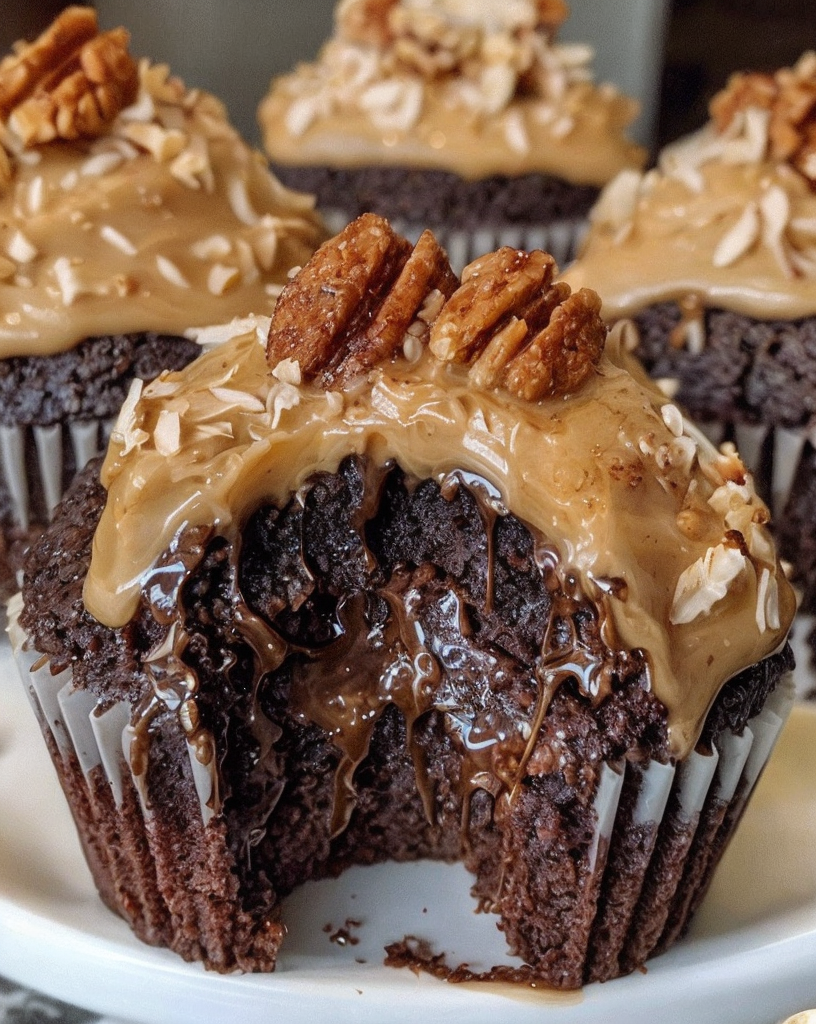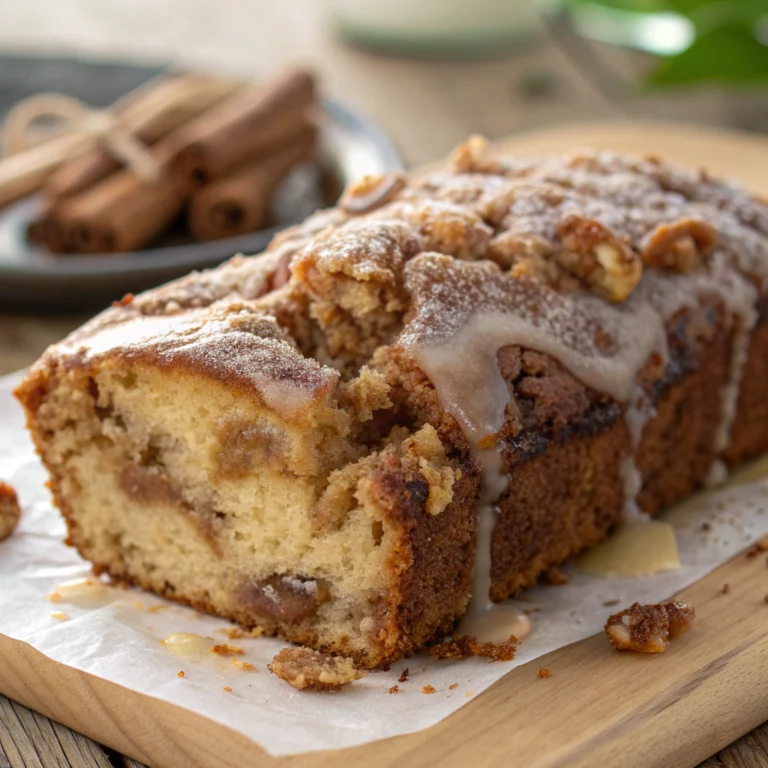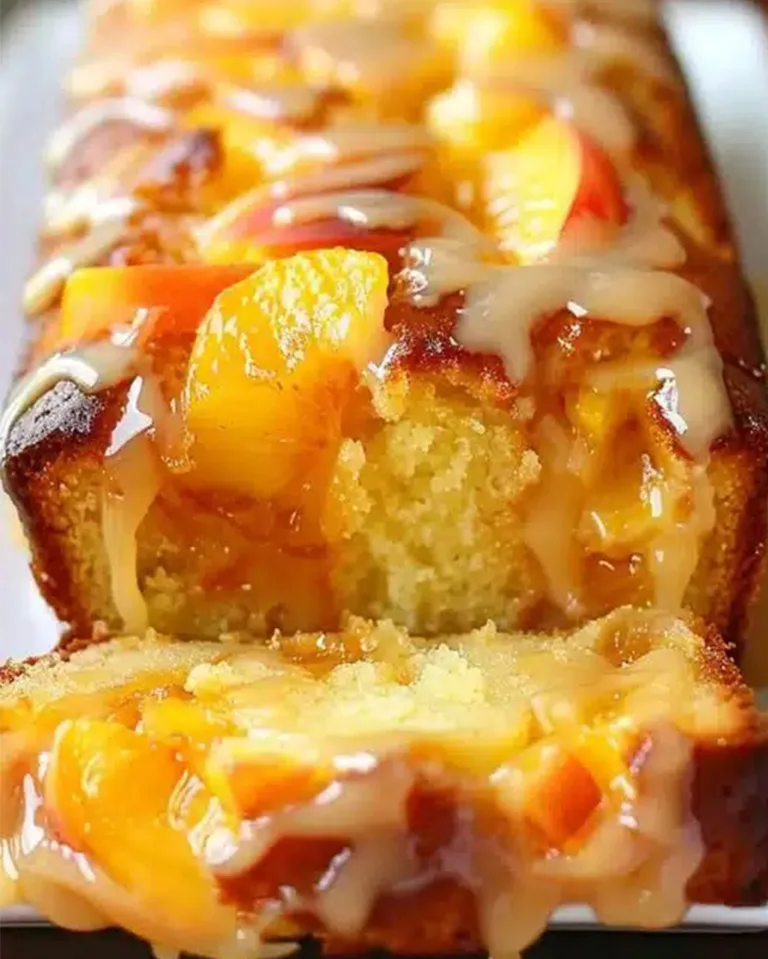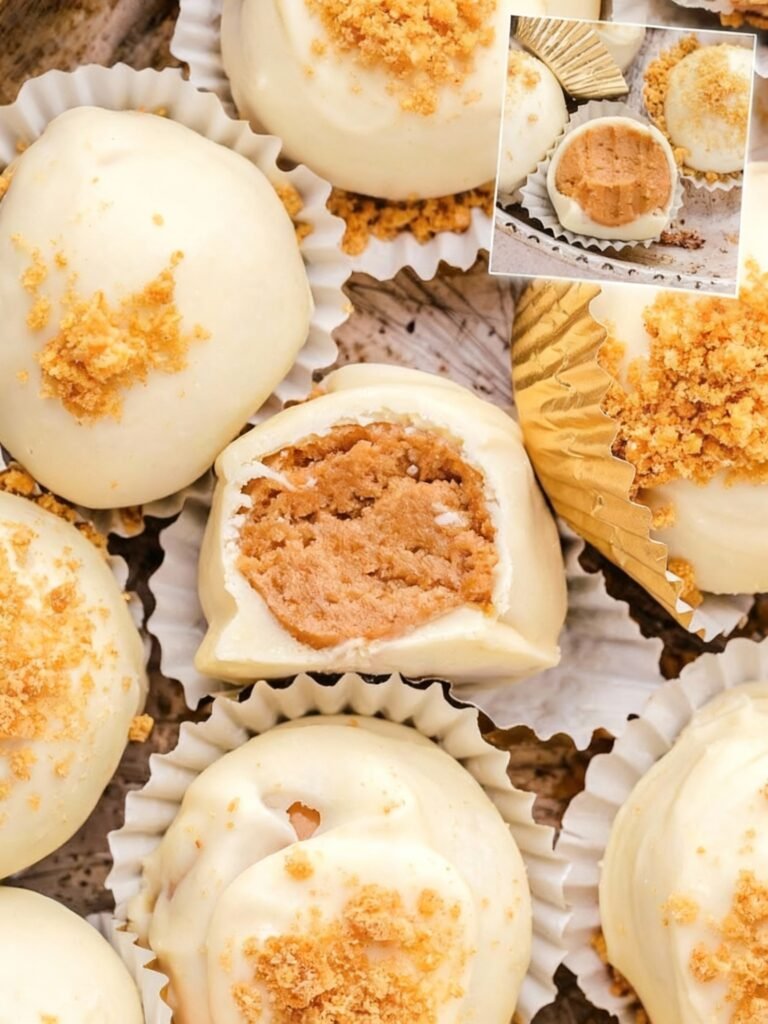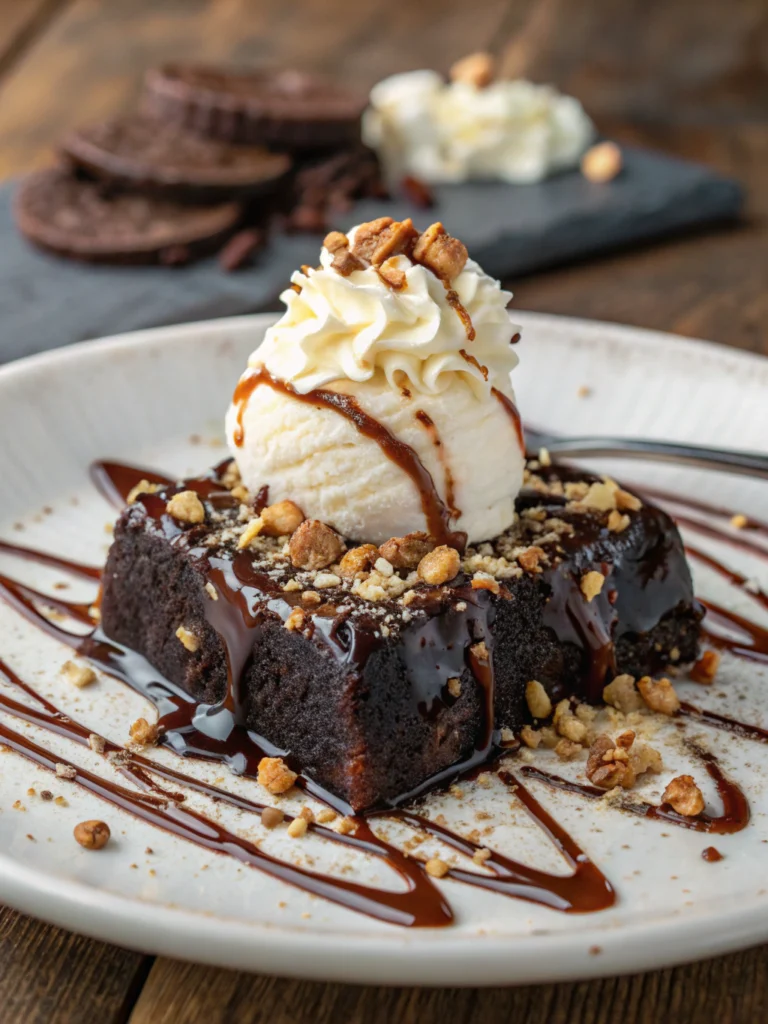Irresistible German Chocolate Cupcakes – Best Recipe (Family Favorite)
Irresistible German Chocolate Cupcakes: A Sweet Delight
Indulge in the heavenly combination of chocolate and coconut with our irresistible German Chocolate Cupcakes. These delightful treats are perfect for any chocolate lover, featuring a rich and moist chocolate base topped with a gooey coconut and pecan frosting. Whether for a special occasion or a sweet craving, these cupcakes deliver a satisfying bite of sweetness in each morsel.
The deep chocolate flavor is perfectly complemented by the nutty and tropical notes in the frosting. The luscious topping adds a layer of decadence, enhancing the chocolate’s bittersweet essence. Each bite is a celebration of contrasting textures and flavors that come together harmoniously.
Quick Recipe Highlights
- Flavor Profile: An exquisite blend of rich chocolate, sweet coconut, and earthy pecans.
- Texture: Moist chocolate cupcakes with a creamy, crunchy frosting for a delightful contrast.
- Aroma: Inviting notes of roasted nuts and warm cocoa fill your kitchen.
- Visual Appeal: Beautifully rustic with a dollop of frosting crowned by pecans and coconut shreds.
- Skill Level Needed: Intermediate; perfect for home bakers with a bit of experience.
- Special Equipment: A hand mixer, muffin tin, and piping bag for well-defined frosting.
Recipe Overview
- Difficulty Level: This recipe is rated as intermediate due to the need for precise ingredient measurements, especially in making the frosting.
- Category: Desserts & Sweets; ideal for satisfying your sweet tooth or serving at gatherings.
- Cuisine: German-inspired, bringing traditional flavors to a cupcake format.
- Cost: Moderate; uses pantry staples with the addition of coconut and pecans.
- Season: Suitable year-round but especially delightful in spring and summer.
- Occasion: Perfect for birthdays, holidays, or casual get-togethers with friends and family.
Why You’ll Love This Recipe
Savor every bite of these German Chocolate Cupcakes, where each morsel is an ode to taste and texture. The rich cocoa flavor mingles seamlessly with the coconut-infused frosting, offering a dessert experience like no other. Ideal for both chocolate lovers and those who enjoy a touch of tropical flair, these cupcakes are bound to please any palate.
Convenience is at the forefront of this recipe. With ingredients easily found in most grocery stores, whipping up these treats is a breeze. The steps are straightforward, and with a little organization, you can have these cupcakes ready to impress your guests promptly. The aroma of baking chocolate will fill your home with a welcoming warmth.
Beyond their taste and convenience, these cupcakes also hold nutritional highlights. Each ingredient carries its own benefits; from energy-boosting sugars to healthy fats found in pecans and coconut. While indulgent, they can be part of a balanced treat choice.
These cupcakes are a golden ticket to social success. They serve as an excellent conversation starter at parties and are sure to be the star dessert at family gatherings. The frosting’s unique texture and taste will likely win hearts and bring joy to anyone lucky enough to indulge.
Cost-effectiveness is another reason to fall in love with this recipe. With careful shopping and bulk buys, especially the nuts and chocolate, these cupcakes can be made affordably. They allow you to offer a gourmet treat without the price tag of a high-end bakery.
Historical Background and Cultural Significance
The story of German Chocolate Cupcakes begins in the mid-19th century with the development of a type of dark-baking chocolate by a man named Samuel German. It was Baker’s German’s Sweet Chocolate that provided the foundation for what would become known as “German’s Chocolate Cake.” Debuting in 1957, the recipe took the culinary world by storm via a published article in a Dallas newspaper, catapulting it into the limelight.
German Chocolate Cupcakes pay homage to the original cake but offer a singular portion for easy enjoyment. Their journey from a full-sized cake to an individual dessert symbolizes the adaptation of culinary traditions to suit modern lifestyles. Regional variations have since emerged due to ingredient availability and taste preference.
Culturally, these cupcakes are a fusion of chocolate richness and the exotic allure of coconut, known for representing hospitality in many vacation-themed cuisines. They embody a cross-border culinary appeal, melting the boundaries between traditional German chocolate elements and innovative interpretations.
In today’s baking world, German Chocolate Cupcakes continue to be a staple, transcending seasonal boundaries and making appearances at various events. They are cherished for their cultural story and flavor but have also evolved to align with dietary needs—a testament to their enduring flexibility and popularity.
Ingredient Deep Dive
Cocoa Powder: Cocoa powder is the essence of these cupcakes. Known for its dark and robust flavor, it has been a beloved baking ingredient for centuries. Cocoa beans, harvested mostly in West Africa, are ground and processed to create this miraculous powder. When selecting cocoa powder, opt for high-quality and unsweetened varieties for an authentic chocolate taste. Store it in a cool, dry place to maintain its flavor and prevent clumping.
Coconut: This ingredient plays a starring role in the frosting, offering not only texture but also natural sweetness and moisture. Coconut has a rich history in tropical and subtropical regions, celebrated for its versatility and health benefits. It’s packed with healthy fats and dietary fiber, making it a beneficial addition beyond its delicious taste. To keep it fresh, store it in an airtight container and consider toasting to enhance flavor before using.
Common Mistakes to Avoid
- Overmixing the batter can lead to dense cupcakes. Mix until just combined for a light, fluffy texture.
- Not sifting dry ingredients may result in lumps, affecting overall batter consistency.
- Using sweetened coconut can overpower the icing. Unsweetened coconut provides better control over the sweetness level.
- Ignoring temperature requirements can cause the icing to separate. Cool before spreading for best results.
- Skipping cupcake liners makes removal challenging. Liners ensure easy handling and presentation.
- Overfilling cupcake tins leads to overflow. Fill only halfway to allow room for rising.
- Under-baking results in gooey centers. A toothpick test should come out clean from the center.
- Leaving pecans whole may impact texture. Chop them for a more even distribution.
- Storing in a warm area accelerates spoilage. Refrigerate if not eaten within one day for freshness.
Essential Techniques
Properly creaming the butter and sugar is crucial for light cupcakes. This technique incorporates air into the batter, creating the desired fluffy texture. Be patient and allow sufficient mixing time until the mixture is pale and frothy. A common pitfall is using cold butter, which doesn’t cream well and affects texture.
Layering the frosting evenly requires methodical application. Start from the center of each cupcake and spread outward in gentle circles. Visual cues for success include smooth application without separation. Mastering this ensures a professional appearance while avoiding clumps.
Pro Tips for Perfect German Chocolate Cupcakes
Ensure all ingredients are at room temperature before starting. Cold ingredients can cause batter separation. Allow them to sit out for at least an hour beforehand.
Measure your dry ingredients accurately using a kitchen scale. This ensures a uniform cupcake structure and consistency in flavor.
Toast pecans before adding them to the frosting. This brings out their nutty flavor, adding richness to the overall cupcake taste.
Use a piping bag with a round tip for neat and uniform cupcake frosting application, providing a beautiful visual effect.
For added chocolate luxury, fold in mini chocolate chips to the batter before baking. This gives an extra chocolatey surprise in every bite.
Add a pinch of salt to the chocolate batter. It enhances the chocolate’s natural flavors and keeps the sweetness in check.
Consider chilling your cupcakes briefly before serving. This allows the frosting to set, making them easier to handle and eat.
Variations and Adaptations
Embark on a global culinary journey by exploring regional variations. For example, swap out the pecans for macadamia nuts for a Hawaiian twist. This adaptation complements the coconut’s tropical character, offering a new flavor dimension.
To match seasonal cravings, adapt the chocolate base by incorporating pumpkin puree in autumn. This introduces warm, earthy notes, reminiscent of fall desserts, making them a holiday favorite.
For dietary preferences or restrictions, try using almond flour for a gluten-free alternative. This maintains moistness while adding a subtle nuttiness, ensuring that those with gluten sensitivities can enjoy these cupcakes too.
For a summer celebration, add dried pineapple or mango bits into the frosting. This introduces a fruity element that pairs exceptionally well with coconut and chocolate, creating a vibrant, summery dessert.
Alter the frosting texture by beating cream cheese into the coconut mix for extra creaminess and a slight tang—great for those who prefer less sweetness in icing.
“H2″>Serving and Presentation Guide
Achieve Insta-worthy plating with strategic garnishing techniques. Consider topping each cupcake with a pecan half or a sprinkle of toasted coconut for added elegance. These simple yet effective touches elevate both taste and presentation.
Traditional accompaniments, such as a scoop of vanilla ice cream, complement the rich cocoa flavors, adding a creamy dimension to the dessert course. Modern alternatives like a dollop of whipped coconut cream offer non-dairy options with similar comfort and satisfaction.
To best enjoy these, serve at room temperature when the frosting is at its creamiest. If refrigerated, allow them 20 minutes at room temperature before serving for optimized flavor.
Manage portions by keeping the cupcakes small, perfect for individual indulgence without overindulgence. Their single-serving nature confirms their practicality and control for caloric intake.
Wine and Beverage Pairing
Pair these cupcakes with a rich Port wine or a sweet Moscato. These drink choices enhance the chocolate’s depth, complementing the cupcake without overpowering its flavor profile.
For a non-alcoholic alternative, try pairing these cupcakes with a robust black coffee or a rich, unsweetened iced tea. Both offer a welcoming counterbalance to the sweetness of the dessert.
If your guests enjoy coffee, offer a selection of espressos or café au lait for an elevated dessert pairing. This coffee depth complements the chocolate and coconut blends beautifully.
Temperature considerations for beverage pairing include serving wines slightly chilled and coffee piping hot to create a delightful contrast with the baked treat.
Serve beverages alongside the dessert course immediately after plating for a warm and satisfying experience.
Storage and Shelf Life
Keep these cupcakes fresh by storing them in an airtight container at room temperature for up to two days. Refrigeration is recommended if weather conditions are hot and humid, ensuring the frosting remains stable.
Temperature requirements for storage ensure the quality of the frosting. A consistent, cool environment prevents separation and maintains texture.
Choose a sturdy, plastic container with a tight seal for storage. This method preserves moisture and prevents exposure to external contaminants, keeping the cupcakes fresh.
Signs of spoilage include off odors, discoloration of frosting, or dryness. If noticeable, it’s best to discard to avoid unpleasant eating experiences.
Reheat cupcakes briefly in a microwave for about five seconds if refrigerated, just enough to soften before consuming.
Freezing is possible for extended storage. Wrap each cupcake individually in plastic wrap before sealing in a freezer bag. Thaw overnight in the refrigerator before enjoying.
Make Ahead Strategies
Maximize efficiency by preparing components ahead of time. Bake the cupcakes a day in advance and store them in an airtight container to save prep time on the actual serving day.
Store frosting separately in the refrigerator in an airtight container. Before using, allow it to come to room temperature and give it a quick whip for ultimate smoothness.
Ensure quality by assembling the cupcakes close to serving time. A gap between frosting and serving can compromise texture but allows flavors to meld.
Reheating guidelines emphasize brief moments in the microwave to regain structure if stored in cool conditions. For freshness, add any fresh fruit or garnishes at the time of serving.
For large gatherings, prewrap individual cupcakes for grab-and-go scenarios, promising ease for guests and minimal mess.
Scaling Instructions
To halve the recipe, maintain ratios of wet to dry ingredients for consistent texture. This adjustment ensures the batter remains cohesive without compromising structure.
Doubling or tripling requires careful attention to mixing times and oven load to ensure even baking. Consider baking in smaller batches for perfect results each time.
Equipment adjustments for larger batches may involve using larger mixing bowls or multiple muffin tins to manage volume without compromising quality.
Timing modifications might see a slight increase due to larger batches needing more precise monitoring, so adjust baking hours accordingly.
Storage considerations suggest using multiple containers for larger quantities, preventing overcrowding and preserving the integrity of each cupcake.
Nutritional Deep Dive
Understanding nutritional values, these cupcakes offer a balanced array of macros and micros. A single cupcake delivers essential carbohydrates for energy, with fats primarily from coconut and pecans—useful for satiety and healthy fats.
Micronutrients such as magnesium from cocoa and vitamin E from pecans provide additional health benefits beyond basic nutrition. Health-conscious individuals can enjoy these as an occasional treat benefiting heart health.
Dietary considerations include managing sugar intake, balancing these cupcakes within a broader diet plan to enjoy without guilt.
Portion analysis aids in understanding the calorie count, allowing these treats to fit modestly within daily nutritional goals, emphasizing moderation.
Weight management tips encourage mindful eating. Choosing smaller portions ensures that these indulgences remain pleasurable without disrupting dietary discipline.
Dietary Adaptations
For gluten-free adjustments, substitute all-purpose flour with a gluten-free alternative like almond flour. This substitution maintains texture while providing an inclusive option for various preferences.
Dairy-free variations use coconut oil or margarine where butter is needed. This swap does not compromise flavor and aids those with lactose intolerance.
Vegan adaptations involve replacing eggs with applesauce or a flaxseed and water blend. These alternatives offer similar moisture and binding properties without animal products.
For low-carb needs, consider using almond or coconut flour instead of regular flour, slightly altering the recipe structure without affecting quality.
Keto adaptations embrace almond flour, coconut flakes, and erythritol for sweetness, providing low-carb enthusiasts a guilt-free pleasure.
Paleo choices may see almond butter and coconut sugar in place of traditional ingredients, aligning with whole food philosophies.
Low-FODMAP adjustments can include using lactose-free, low-sugar chocolate ingredients. These considerations support dietary sensitivity without sacrificing enjoyment.
The Recipe
Irresistible German Chocolate Cupcakes
Serves: 12 cupcakes
Prep Time: 30 mins
Cook Time: 25 mins
Total Time: 55 mins
Kitchen Equipment Needed
- Muffin tin
- Mixing bowls
- Hand mixer
- Piping bag
- Whisk
- Spatula
Ingredients
- 1 cup all-purpose flour
- 1/2 cup cocoa powder
- 1 tsp baking soda
- 1/2 tsp salt
- 1 cup granulated sugar
- 1/2 cup unsalted butter, room temperature
- 2 large eggs
- 1 tsp vanilla extract
- 1/3 cup buttermilk
- 1/2 cup hot water
- 1 cup unsweetened coconut flakes
- 3/4 cup chopped pecans
- 1/2 cup evaporated milk
- 1/4 cup brown sugar
- 1/4 cup butter
- 1/2 tsp vanilla extract (for frosting)
Directions
- Preheat your oven to 350°F (180°C) and line a muffin tin with cupcake liners.
- In a bowl, whisk together flour, cocoa powder, baking soda, and salt.
- Cream sugar and butter until light and fluffy. Add eggs one at a time, beating well with each addition. Stir in vanilla.
- Alternately add dry ingredients and buttermilk to the butter mixture, starting and ending with dry ingredients. Stir in hot water. Batter will be thin.
- Pour batter into prepared muffin tin, filling each cup halfway. Bake for 20-25 minutes or until a toothpick comes out clean. Cool on a wire rack.
- For the frosting, combine coconut, pecans, evaporated milk, brown sugar, and butter in a saucepan. Cook over medium heat, stirring until thickened. Add vanilla extract and cool slightly.
- Frost cooled cupcakes and enjoy.
Recipe Notes
- For extra texture, toast the coconut flakes before adding them to the frosting.
- Store frosted cupcakes in the refrigerator if not consumed within a day.
Troubleshooting Guide
Discover solutions for texture issues by ensuring proper ingredient measurements and thorough mixing, which prevent heaviness and resulting dense cupcakes.
Flavor balance can be restored by adjusting sugar levels. If outcomes are overly sweet, reduce sugar slightly in the batter or frosting without compromising structure.
Temperature problems are often tied to monitoring your oven. Use a thermometer to guarantee accurate baking conditions, conducive to even cooking.
For equipment challenges, adapt ingredient quantities to fit available tools, ensuring even cooking and optimal results in line with your gear.
Ingredient substitutions should be handled with care, maintaining proportions for stable batter. For instance, replace butter with equal parts margarine and test for consistency.
Concerns with timing require diligent testing; insert a toothpick into cupcakes to check readiness. Allow cupcakes cooling down; this aids final frosting adhesion, ensuring a successful bake.
Recipe Success Stories
Our community bakes these German Chocolate Cupcakes with enthusiasm, reporting rave reviews and spreading smiles. Sharing their success in perfecting the chocolate and coconut blend, they capture household admiration one cupcake at a time.
Creative variations inspire innovation, adding a personalized touch. One reader implemented caramel-infused frosting, while another marbled the batter with coffee essence—a clever tweak enhancing flavors.
Adaptation stories abound, with dietary modifications shared between friends, proving these cupcakes’ versatility and inclusivity, aligning with modern nutrition needs.
Photography tips suggest capturing frostings’ allure by using natural light and careful focus, elevating the visual appeal of these treats on social media.
Community efforts result in newfound techniques, documentation, and shared experiences, growing a collaborative spirit that enriches the baking journey together.
Frequently Asked Questions
Can I use dark chocolate instead of cocoa powder?
Yes, melted dark chocolate can be used, but adjust liquid ingredients to maintain batter consistency, resulting in deep richness.
How can I make the frosting less sweet?
Reducing sugar or using unsweetened coconut milk offers a balanced, flavorful frosting without excessive sweetness.
What oil can be substituted for butter?
Use coconut oil or any neutral-flavored oil in place of butter. Slight changes in texture and flavor are anticipated but remain delicious.
How to achieve a smooth frosting texture?
Cool the frosting mixture before spreading. Proper handling minimizes unpleasant texture variations.
What variation adds a festive touch?
Include crushed peppermint or cranberry bits in the frosting for a holiday-inspired cupcake variation.
Can these be turned into mini cupcakes?
Certainly! Adjust baking time to about 12-15 minutes, monitoring closely, ensuring perfect, bite-sized delights.
What’s the best flour for a gluten-free version?
Almond or coconut flour are excellent gluten-free choices, providing moist consistency across the batter.
Can brown sugar replace white granules in the batter?
Brown sugar adds moisture and a caramel undertone, suitable for denser, flavorful cupcakes.
Are there vegan alternatives for egg replacement?
Applesauce or chia seed gel work well, achieving similar moist textures without eggs.
What temperature ensures cupcakes don’t dry?
Bake at prescribed temperatures with an eye on doneness, avoiding underbaking or overcooking for best results.
Is frosting color customizable?
Natural food colorants can be incorporated without impacting taste, letting creativity flow in visual presentation.
Will refrigerating affect cupcake texture?
If stored properly, refrigeration extends life without dryness. A brief return to room temperature before serving re-establishes softness.
Additional Resources
Explore related recipes like our Classic Chocolate Cake or Cool Coconut Bites to diversify your dessert repertoire, all easily found in our extensive library.
Technique guides highlight essential frosting skills, assisting in achieving flawless decoration for these delightful cupcakes.
Ingredient information offers insight into the finest chocolate sources and how to choose the best baking nuts available, enhancing your overall baking experience.
Equipment recommendations feature the latest innovations in baking ware and tools, ensuring precision and quality in your creations.
Seasonal variations provide inspiration for festive baking, whether autumn harvest or spring bloom-themed dessert ventures.
Join the Conversation
Engagement begins with sharing your cupcake creations online, inviting friends and followers to celebrate and recreate your successful bake.
Photography tips assist in framing and styling your images, ensuring each photo captures the mouth-watering beauty of these cupcakes.
Recipe reviews help refine our collective experience. Share insights that support others in achieving perfect results, strengthening our baking community.
Bring diverse participation through community engagement initiatives. Join discussions, contribute thoughts, and discover new ways to innovate this timeless recipe further.
Embrace recipe variations shared by others, collaborating through experiments to push the boundaries of what makes these cupcakes so fascinating and universally beloved.

